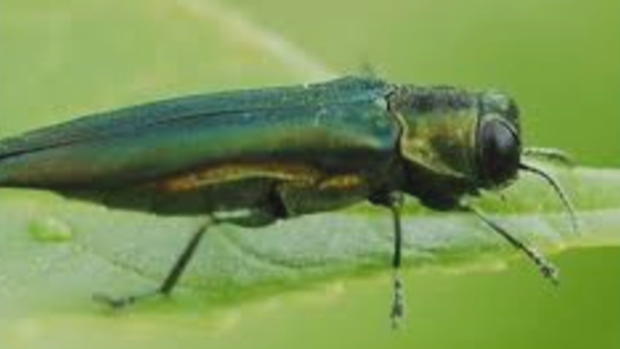Ash Tree-Killing Beetle Now Spreading In Colorado
LONGMONT, Colo. (CBS4) - For the first time since arriving in Boulder in 2013, the invasive emerald ash borer has spread in Colorado.
An arborist detected the pest, and its damage, in a tree in a homeowner's backyard in Longmont on Monday. Experts confirmed the finding on Wednesday.
James Young, owner and operator of Bodhi Tree Care in Longmont, says he was working in a client's yard when he spotted a tree on a neighboring property with a dead branch hanging down.
"I got up there, and sure enough, it was obvious," Young said. "There were several telltale signs."
Such telltale signs include new, unhealthy growth in an ash tree, a dying canopy, and finding D-shaped holes in tree branches, according to Young. Training he has received on emerald ash borer (EAB) helped Young spot the damage.
Young took a piece of the tree to the Longmont Forestry Services department, which shared the specimen with the Colorado Department of Agriculture. Experts also visited the tree, and confirmation of EAB was made by both members of the state's department, and the Colorado EAB Response Team.
"As a tree guy, as an arborist, I constantly look at trees," Young said. "It's sad to see all the ash trees that are here that we're going to lose."
The non-native beetle typically spreads at a rate of one half mile per year. Once it infests an ash tree, the tree typically dies within three to five years. EAB is native to Asia, and was first discovered in the U.S. in 2002 near Detroit. EAB is thought to have arrived through the commercial shipping of wood packing materials from China down the St. Lawrence Seaway.
In the Longmont case, experts do not know whether EAB spread naturally or by human activity, such as from moving wood from one area to another. Keith Wood, community forester for the Colorado State Forest Service, says the discovery confirms what experts have known for years -- that it was a matter of when, not if, the pest would spread.
While not particularly surprising to experts, Wood says confirmation that EAB is on the move means cities and homeowners need to come up with mitigation plans, if they have not already.
"It puts the residents of Longmont on alert here," Wood said. "Know if you have an ash tree, is it a valuable tree you want to preserve or is it something you may want to replace over time, it's time to make those management decisions."
Wood says Northern Front Range communities are most at risk. He estimates up to 15 percent of Colorado's urban and community trees are ash, but that ash trees make up as much as 25 percent of the urban canopy in some areas. In Longmont, there are approximately 43,000 ash trees. Only 2,800 of them are managed by the city's forestry services department, as trees located in parks or public right-of-way areas.
"We do need to be concerned, our urban forests are very valuable here," Wood said.
In response to Wednesday's finding, Longmont city forester Ken Wicklund hopes to speed up mitigation efforts. Rather than continue to identify and remove unhealthy ash trees, as his department has done in anticipation of EAB's arrival, Wicklund soon hopes to begin chemically treating trees. To treat 300 trees each year the city will need to carve up to $47,000 out of its budget, according to Wicklund. He encourages property owners not to wait in deciding whether their ash trees are worth saving.
"I think we've still got a window of time here, but we've got to be diligent in dealing with this now."
With treatments running into the thousands of dollars for large ash trees, Young recommends in some cases property owners consider replacing, instead of trying to save, their ash trees. And, he says, don't move around wood that could be infested.
"Get your firewood where you're going camping," Young said. "Spend an extra five bucks, it could help save a forest."
From the Colorado State Forest Service:
Top Five EAB tips for Longmont and Front Range Residents:
• Determine now if you have any ash trees. Identifying features of ash trees include compound leaves with 5 to 9 leaflets; leaflets, buds and branches growing directly opposite from one another; and diamond-shaped bark ridges on mature trees.
• If you have an ash tree, start planning. Decide if the overall health of the tree merits treatment or if it would be best to remove and replace it with a different species. If you aren't sure, contact a certified arborist. If pesticide treatment is the preferred option, the applicator must be licensed by the CDA as a Commercial Pesticide Applicator.
• Recognize signs of EAB infestation. Property owners with ash trees should be on the lookout for thinning of upper branches and twigs, loss of leaves, D-shaped 1/8-inch holes on the bark, vertical bark splitting or increased woodpecker activity. Report suspect trees by calling the Colorado Department of Agriculture at 1-888-248-5535 or filling out their EAB Report Form at https://www.colorado.gov/pacific/agplants/eab-identification-and-reporting.
• Be aware of EAB imposters. Other insects like lilac/ash borer, ash bark beetle and flat-headed apple tree borer may look like EAB or cause similar tree symptoms. For more information, visit www.eabcolorado.com.
• Help prevent further spread of EAB. Do not transport ash or any hardwood firewood, or any other untreated ash wood products, to other locations. Boulder County and some surrounding areas are under a federal EAB quarantine, allowing for stiff fines for those who move untreated wood from the area.
For more information about ash tree identification, the symptoms of EAB and treatment options, go www.eabcolorado.com or www.csfs.colostate.edu/emerald-ash-borer.
Lauren DiSpirito is CBS4's Northern Newsroom reporter. Follow her on Twitter @CBS4Lauren. Share your story ideas with her here.






